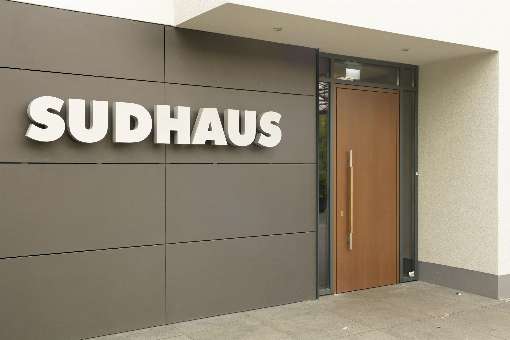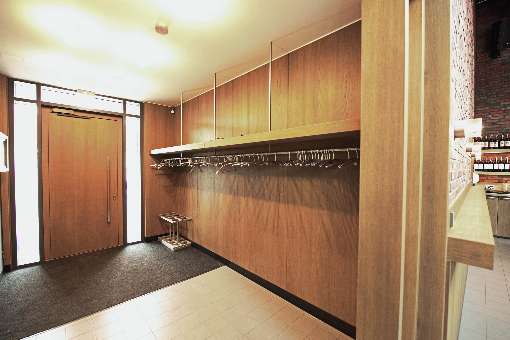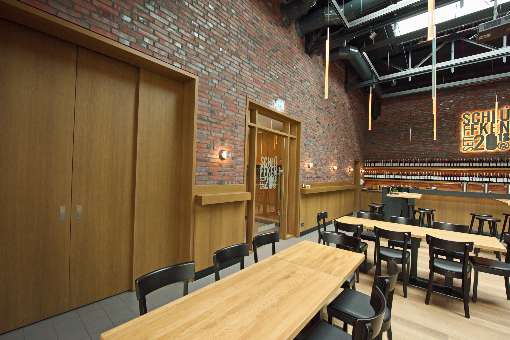13.06.2019
It was a long-cherished dream of the Furth family. A small, high-quality and locally based artisan brewery based on the motto: “Beer needs roots”. The result of these deliberations is convincing. A modern and fresh style with a high, light hall kept in subtle colours, which is in front of the actual brewery, invites people to come in and enjoy a pleasant stay. The woodwork was carried out by the local Wans master joiner's workshop. European oak veneer was chosen, 1.5 millimetres thick with a fine, balanced grain. “The special feature is the deliberately identifiable natural wood property, thanks to the log matching”, explained Florian Koch, co-owner of Wilfried Koch KG in Krefeld, whose company supplied the veneers for producing the panels that were ultimately installed. Smoke-effect stain with matt varnish was used for the surface colour. Koch explained: “The oak panels in the counter area were surrounded with granite. That lends the room plain elegance and warmth.” Ursula Geismann, Secretary of Initiative Furnier + Natur (IFN), added: “Veneer truly is an all-rounder. No matter what the natural material from the best the forest has to offer is combined with: the result is always attractive and elegant.” IFN/DS
How veneer is made: Veneer is obtained from the wood of selected trees, which are mainly grown in sustainably managed forests. The tree species used most are Maple, Beech, Oak, Ash and Walnut from domestic, European and in the case of Oak, Maple and Walnut, from American forests too. If the right tree has been found it is peeled, sliced or sawn. This produces sheets of wood, which are around 0.45 to 6 millimetres thick. These are dried, stacked according to quality and grade, are cut and are put together to form a deck. These veneer decks are then bonded and pressed onto substrate materials such as solid wood laminboards, particleboards, MDF panels, multiplex panels or plywood.
Initiative Furnier + Natur (IFN)
Initiative Furnier + Natur (IFN) e.V. was founded in 1996 by the German veneer industry and its partners. The purpose of the association based in Bad Honnef is to promote veneer as a material. It is funded and supported by European companies in the veneer industry, trade and the veneer processing industry as well as professional associations of the timber industry.
Photo 1: Entrance to the Sudhaus. Photo: Schreinerei Wans
Photo 2: Entrance area with fine veneer panels. Photo: Schreinerei Wans
Photo 3: Pleasant ambience in the Sudhaus. Photo: Schreinerei Wans
Downloads
2019-06-13_PM-2019-IFN-Koch-Sudhaus 1.jpg (1.02 MB)
2019-06-13_PM-2019-IFN-Koch-Sudhaus 2.jpg (1.08 MB)
2019-06-13_PM-2019-IFN-Koch-Sudhaus 3.jpg (1.19 MB)
Wilfried Koch KGinHhHin: New Sudhaus in Krefeld fitted out with the finest veneer
Bad Honnef/Krefeld. Wilfried Koch KG - a trader of veneers, sawn timbers and solid wooden panels in Krefeld - has fitted out the new southern building (“Sudhaus”) of the “Schlüffken” brewery in Krefeld's historic northern rail station with oak veneer. The fine wood harmonises perfectly with the other building materials, stone and granite.It was a long-cherished dream of the Furth family. A small, high-quality and locally based artisan brewery based on the motto: “Beer needs roots”. The result of these deliberations is convincing. A modern and fresh style with a high, light hall kept in subtle colours, which is in front of the actual brewery, invites people to come in and enjoy a pleasant stay. The woodwork was carried out by the local Wans master joiner's workshop. European oak veneer was chosen, 1.5 millimetres thick with a fine, balanced grain. “The special feature is the deliberately identifiable natural wood property, thanks to the log matching”, explained Florian Koch, co-owner of Wilfried Koch KG in Krefeld, whose company supplied the veneers for producing the panels that were ultimately installed. Smoke-effect stain with matt varnish was used for the surface colour. Koch explained: “The oak panels in the counter area were surrounded with granite. That lends the room plain elegance and warmth.” Ursula Geismann, Secretary of Initiative Furnier + Natur (IFN), added: “Veneer truly is an all-rounder. No matter what the natural material from the best the forest has to offer is combined with: the result is always attractive and elegant.” IFN/DS
How veneer is made: Veneer is obtained from the wood of selected trees, which are mainly grown in sustainably managed forests. The tree species used most are Maple, Beech, Oak, Ash and Walnut from domestic, European and in the case of Oak, Maple and Walnut, from American forests too. If the right tree has been found it is peeled, sliced or sawn. This produces sheets of wood, which are around 0.45 to 6 millimetres thick. These are dried, stacked according to quality and grade, are cut and are put together to form a deck. These veneer decks are then bonded and pressed onto substrate materials such as solid wood laminboards, particleboards, MDF panels, multiplex panels or plywood.
Initiative Furnier + Natur (IFN)
Initiative Furnier + Natur (IFN) e.V. was founded in 1996 by the German veneer industry and its partners. The purpose of the association based in Bad Honnef is to promote veneer as a material. It is funded and supported by European companies in the veneer industry, trade and the veneer processing industry as well as professional associations of the timber industry.
Photo 1: Entrance to the Sudhaus. Photo: Schreinerei Wans
Photo 2: Entrance area with fine veneer panels. Photo: Schreinerei Wans
Photo 3: Pleasant ambience in the Sudhaus. Photo: Schreinerei Wans
Downloads
2019-06-13_PM-2019-IFN-Koch-Sudhaus 1.jpg (1.02 MB)
2019-06-13_PM-2019-IFN-Koch-Sudhaus 2.jpg (1.08 MB)
2019-06-13_PM-2019-IFN-Koch-Sudhaus 3.jpg (1.19 MB)


